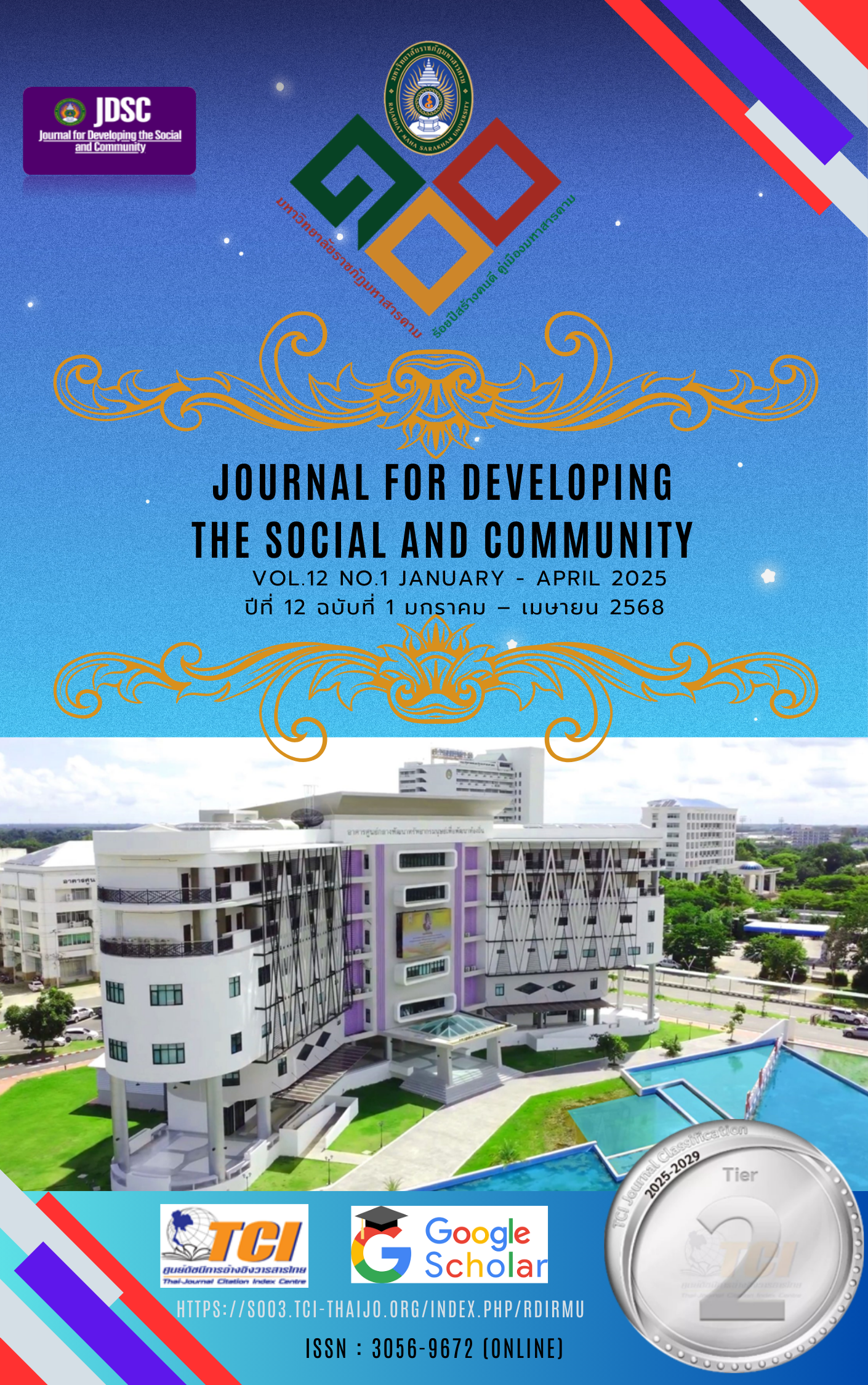Factors Affecting the Operation of Thamanao Subdistrict Administrative Organization
Keywords:
Factors Affecting, Operation, Subdistrict Administrative OrganizationAbstract
Background and Aims: The Subdistrict Administrative Organization (SAO) plays a vital role in local governance, ensuring the delivery of essential public services, infrastructure development, and community welfare at the grassroots level. It fosters citizen participation and addresses localized needs, promoting sustainable development in rural areas. This research aims to (1) study the operation level of Tha Manao Sub-district Administrative Organization, Chai Badan District, Lop Buri Province, (2) study the factors affecting the operation of Tha Manao Sub-district Administrative Organization, Chai Badan District, Lop Buri Province, and (3) study recommendations on factors affecting the operation of Tha Manao Sub-district Administrative Organization, Chai Badan District, Lop Buri Province.
Methodology: Quantitative research was used. The sample consisted of 347 people aged 18 years and over in Tha Manao Sub-district Administrative Organization by using Taro Yamane's formula. The research instrument was a rating scale questionnaire with a reliability of 0.735. The statistics used for data analysis were percentage, mean, frequency, standard deviation and linear multiple regression analysis.
Results: The results of the research found that (1) the operation level of Tha Manao Sub-district Administrative Organization, Chai Badan District, Lop Buri Province was at a high level overall. (2) Factors affecting the operation level of Tha Manao Sub-district Administrative Organization Chai Badan District, Lopburi Province, including factors of public participation, teamwork, resource factors, and leadership factors, can explain the operation of Tha Manao Subdistrict Administrative Organization, Chai Badan District, Lopburi Province (Y) by 77.20 percent with statistical significance at the .05 level and (3) recommendations include promoting leaders to have a clear vision, setting long-term goals, and linking organizational strategies with community needs, such as training in strategic decision-making skills and resource management, supporting clear communication within the team and between departments, and creating various channels for exchanging information, allocating budgets, personnel, materials, equipment, and technology appropriately and sufficiently for each project, setting clear and continuous policies so that the project can operate effectively, and organizing a forum or channel for people to express their opinions on problems and needs in the community.
Conclusion: The research concluded that the Tha Manao Sub-district Administrative Organization operates at a high level, influenced significantly by public participation, teamwork, resources, and leadership, explaining 77.20% of its effectiveness. Key recommendations include fostering visionary leadership, aligning strategies with community needs, improving communication, and ensuring adequate resource allocation for sustainable development.
References
กานติมา วายลม. (2563). ทัศนคติของประชาชนที่มีต่อการบริหารงานของเทศบาลนครปากเกร็ด ตำบลปากเกร็ด อำเภอปากเกร็ด จังหวัดนนทบุรี. วารสารวิจยวิชาการ, 3(1), 111-120.
ทศพล ปรีชาศิลป์. (2560). ความคิดเห็นของประชาชนต่อการบริหารงานเทศบาลตำบลสามชุกตามหลักการบริหารจัดการบ้านเมืองที่ดี. ในการประชุมวิชาการระดับชาติ มหาวิทยาลัยเทคโนโลยี ราชมงคลสุวรรณภูมิ ครั้งที่ 1. (น. 1091-1098). วันที่ 22 มิถุนายน. พระนครศรีอยุธยา: มหาวิทยาลัยเทคโนโลยีราชมงคลสุวรรณ.
บุญชม ศรีสะอาด. (2545). การวิจัยเบื้องต้น (พิมพ์ครั้งที่ 7). กรุงเทพฯ: สุวีริยา.
ประเมิน กาฬภักดี. (2564). ความต้องการของประชาชนต่อการจัดบริการสาธารณะขององค์กรปกครอง ส่วนท้องถิ่น กรณีศึกษาองค์การบริหารส่วนตำบลทะเลบก อำเภอดอนเจดีย์ จังหวัดสุพรรณบุรี. วารสารวิชาการสถาบันวิทยาการจัดการแห่งแปซิฟิค, 9(1), 5-18.
สุภาวดี ช่อสม. (2563). ทัศนคติของประชาชนที่มีต่อการบริหารงานด้านการพัฒนาสังคมขององค์การบริหารส่วนตำบลสินเจริญ อำเภอพระแสง จังหวัดสุราษฏร์ธานี. วารสารสังคมศาสตร์และมานุษย วิทยาเชิงพุทธ, 5(1), 1-14.
องค์การบริหารส่วนตำบลท่ามะนาว. (2564). ยุทธศาสตร์การพัฒนาองค์การบริหารส่วนตำบล. ลพบุรี: องค์การบริหารส่วนตำบลท่ามะนาว.
องค์การบริหารส่วนตำบลท่ามะนาว. (2567). รายงานผลการดำเนินงานประจำปี 2567. ลพบุรี: องค์การบริหารส่วนตำบลท่ามะนาว.
Andrews, R. and Boyne, G.A. (2010). Capacity, leadership, and organizational performance: Testing the black box model of public management. Public Administration Review, 70(3), 443–454.
Andrews, R., & Boyne, G. A. (2010). Capacity, leadership, and organizational performance: Testing the black box model of public management. Public Administration Review, 70(3), 443–454.
Boyne, G. A. (2003). Sources of public service improvement: A critical review and research agenda. Journal of Public Administration Research and Theory, 13(3), 367–394.
Boyne, G.A. (2003). Sources of public service improvement: A critical review and research agenda. Journal of Public Administration Research and Theory, 13(3), 367–394.
Burns, J.M. (1978). Leadership. New York: Harper and Row.
Cingolani, L. (2013). The state of state capacity: A review of concepts, evidence, and measures. MERIT Working Papers. Maastricht Economic and Social Research Institute on Innovation and Technology.
Collins, B., & Gerber, T. (2006). Flexibility in disaster management: A key to success. Journal of Crisis Management Studies, 12(4), 345-362.
Goleman, D. (1998). Working with Emotional Intelligence. New York: Bantam Books.
Hackman, J. R., & Johnson, C. E. (2013). Leadership: A communication perspective (6th ed.). Waveland Press.
Hackman, J.R. (2009). Leading teams: Setting the stage for great performances. Harvard Business Press.
Hackman, J.R. and Johnson, C.E. (2013). Leadership: A Communication Perspective. (6th ed.). Waveland Press.
Kim, S. (2006). Public trust in government in Korea: Determinants and implications for behavior. Public Administration Review, 66(5), 646–658.
Kotter, J.P. (1996). Leading change. Boston, MA: Harvard Business School Press.
Mayer, R. C., Davis, J. H., & Schoorman, F. D. (1995). An integrative model of organizational trust. Academy of Management Review, 20(3), 709-734.
Mayer, R.C., Davis, J.H. and Schoorman, F.D. (1995). An integrative model of organizational trust. Academy of Management Review, 20(3), 709-734.
MDPI. (2024). Citizen participation practices in the governance of local food systems: A literature review. Sustainability, 16(14), 5990.
Mintzberg, H. (1993). Structure in fives: Designing effective organizations. Englewood Cliffs, NJ: Prentice Hall.
Ostrom, E. (1990). Governing the commons: The evolution of institutions for collective action. Cambridge: Cambridge University Press.
Pfeffer, J. and Salancik, G.R. (1978). The external control of organizations: A resource dependence perspective. New York: Harper and Row.
Soonhee, K. (2006). Civic engagement and e-participation in public administration: Comparative analysis. Government Information Quarterly, 23(2), 167–180.
Tichy, N.M. and Devanna, M.A. (1986). The transformational leader. New York: Wiley.
Tovar, J. (2015). The role of local government in fostering participation: Evidence from Vietnam. Asian Journal of Political Science, 23(3), 316–335.
Whittle, A. and Rafferty, A. (2012). Framing in organizational change processes: The use of metaphor in a regional health authority. Public Administration, 90(2), 351–369.
Downloads
Published
How to Cite
Issue
Section
License
Copyright (c) 2025 Journal for Developing the Social and Community

This work is licensed under a Creative Commons Attribution-NonCommercial-NoDerivatives 4.0 International License.
Articles that are published are copyrighted by the authors of the articles







